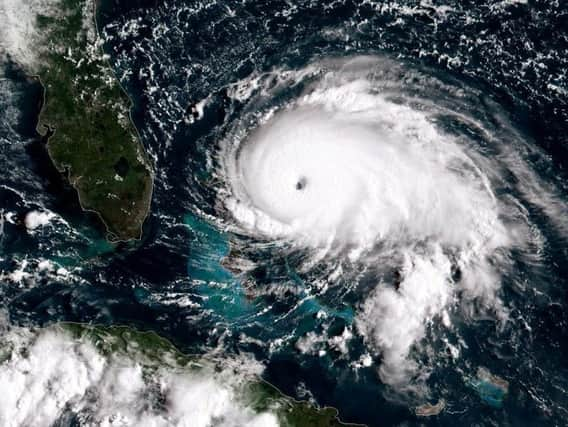Death toll in Bahamas rises as Hurricane Dorian moves towards Florida


The catastrophic onslaught sent floodwaters up to the second floors of some buildings, trapped people in attics and led to others fleeing from one shelter to another.
The storm's relentless winds and rain battered homes and businesses on the islands of Abaco and Grand Bahama, which have a combined population of about 70,000 and are no more than 40ft above sea level at their highest points.
The Grand Bahama airport was said to be under 6ft of water.
Advertisement
Hide AdAdvertisement
Hide AdAs of daybreak on Tuesday, Dorian's winds had dipped to 120mph, making it a still highly dangerous Category 3 hurricane. The storm was at a standstill, with part of its eyewall having hung over Grand Bahama Island since Sunday night.
The storm was centred 35 miles north-east of Freeport and 110 miles off West Palm Beach, Florida.
Hurricane-force winds extended out as far as 45mph in some directions.
The Bahamas' prime minister Hubert Minnis said: "We are in the midst of a historic tragedy. The devastation is unprecedented and extensive."
Dorian is expected to approach the Florida coast later on Tuesday, but the threat to the state has eased significantly, with the National Hurricane Centre's projected track showing most of the coast falling outside the cone of potential landfall.
No place in Florida has more than an 8% chance of getting hit by hurricane-force winds, the service said.
Over the long Labour Day holiday weekend in the US, hundreds of thousands of people in Florida, Georgia and South Carolina - more than 800,000 in South Carolina alone - were ordered to evacuate amid fears Dorian could bring life-threatening storm-surge flooding even if the hurricane's centre stays offshore, as forecast.
Several large airports announced closures, and hundreds of flights were cancelled.
Advertisement
Hide AdAdvertisement
Hide AdThe US Coast Guard airlifted at least 21 people who were injured on Abaco Island, which Dorian hit on Sunday with sustained winds of 185mph and gusts of up to 220mph, a strength matched only by the Labour Day hurricane of 1935, before storms were given names.
Scientists say climate change generally has been fuelling more powerful and wetter storms, and the only recorded hurricane more powerful than Dorian was Allen in 1980, with 190mph winds, though it did not hit land at that strength.
Bahamian officials said they received a "tremendous" number of calls from people in flooded homes.
One radio station said it fielded more than 2,000 distress messages, including reports of a five-month-old baby stranded on a roof and a woman with six grandchildren who cut a hole in a roof to escape rising floodwaters. At least two designated storm shelters flooded.
Dorian was blamed for one death in Puerto Rico at the start of its path through the Caribbean.
Mr Minnis said many homes and buildings were severely damaged or destroyed. Choppy brown floodwaters reached as high as roofs and the tops of palm trees.
Parliament member Iram Lewis said he feared that waters would keep rising and stranded people would lose contact with officials as mobile phone batteries died.
"It is scary," he said, adding that people were moving from one shelter to another as floodwaters kept surging. "We're definitely in dire straits."
Advertisement
Hide AdAdvertisement
Hide AdForecasters said that the storm had come to a near standstill because the steering currents in the atmosphere had collapsed, but that Dorian would resume moving later in the day, getting close to Florida late on Tuesday into Wednesday evening, before reaching the Georgia and South Carolina coasts on Wednesday night and Thursday.
While it is expected to stay offshore, meteorologist Daniel Brown cautioned that "only a small deviation" could draw the storm's dangerous core toward land.
In South Carolina, the major Interstate 26 road was turned into a one-way evacuation route away from Charleston on the coast, and Georgia governor Brian Kemp likewise planned to reverse lanes on I-16 on Tuesday to increase the flow of traffic away from the danger zone.
Mr Kemp said: "We're taking the 'better safe than sorry' attitude."